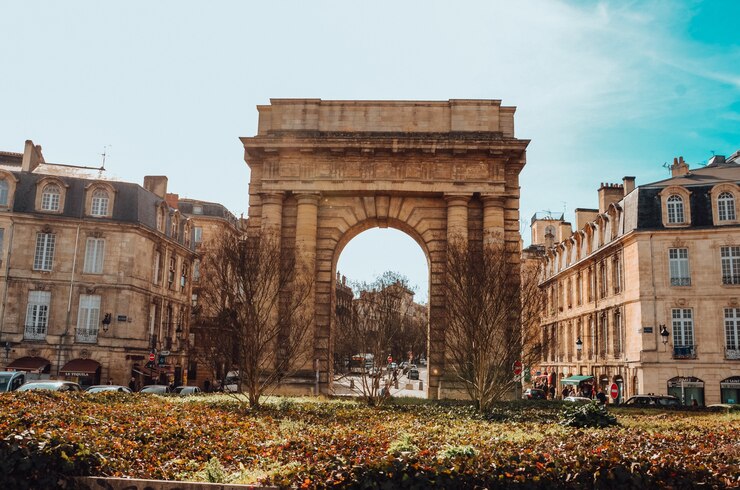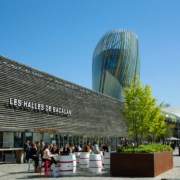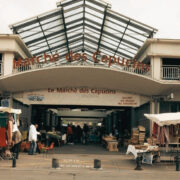
The 6 gates of Bordeaux, the entrances to the old city
Bordeaux is a city that combines history, art and culture, and offers visitors an impressive architectural heritage. Among its most outstanding jewels are the Bordeaux gates, which once served as entrances to the walled city. These gates bear witness to the evolution of Bordeaux over the centuries, and reflect the different styles and periods that have marked its identity.
Would you like to discover them and their secrets? Then don’t miss this article and join us on this fascinating tour of the 6 gates of Bordeaux. And if you want to explore more of the city, don’t hesitate to join our free tour of Bordeaux!.
What are the Bordeaux gates?
The Bordeaux gates are ancient entrances that allowed people to enter and leave the city when it was surrounded by a wall. The first wall was built in the 3rd century, during Roman times, and had four gates:
- The Aquitaine Gate
- The Great Bell Gate
- The Mint Gate
- The Cailhau Gate.
These gates are still preserved today, albeit with some modifications and restorations.
The second wall was built in the 14th century to extend the perimeter of the city and protect it from English attacks. This wall had two more gates:
- The Burgundy Gate
- The Dijeaux Gate.
These also remain standing, albeit with some changes. The Bordeaux gates are historical monuments that are part of the old town of Bordeaux, a UNESCO World Heritage Site since 2007. Each of them has its own history, its own architecture and its own charm. Here we present them to you one by one, so that you can get to know them better.
1. Porte d’Aquitaine: the oldest of Bordeaux’s gates
The Porte d’Aquitaine (Porte d’Aquitaine in French) is the first of Bordeaux’s gates, and the only one remaining from the Roman period. It is located in the Place de la Victoire, south of the historic centre, and marks the beginning of the Rue Sainte-Catherine, the most commercial and lively street in the city.
This gate, also known as the Porte Saint-Julien, was built in 1753 as a triumphal arch in honour of the Duke of Aquitaine. The arch was decorated with reliefs and sculptures, depicting scenes from battles and everyday life. However, over time, it suffered several damages and deteriorations, and lost much of its ornamentation.
Historical facts
- In the 18th century, a tower with a clock and a bell was added, which served to regulate traffic and commerce in the city.
- In the 19th century, a marble statue was added, representing the goddess Minerva, the protector of Bordeaux.
Curiosities of the Aquitaine Gate
- The gate owes its name to the region of Aquitaine, of which Bordeaux was the capital in the Middle Ages.
- In the 19th century, the gate housed a prison inside.
- Today, the Porte d’Aquitaine is one of the most photographed monuments in Bordeaux.
2. Porte de la Grosse Cloche: a landmark in Bordeaux’s history
Bordeaux’s Porte de la Grosse Cloche is one of the most emblematic of Bordeaux’s gates. It is located on rue Saint-James, west of the historic centre, and is part of the old Roman wall.
Built in the 15th century, it owes its name to the huge bell that crowns its central tower. This bell, cast in 1775, weighs more than 7 tons and still strikes the hours today.
But the Great Bell Gate is much more than just a clock tower. Throughout Bordeaux’s history, it has witnessed many important events. For example, it was here that the annexation of Bordeaux to the French crown was officially proclaimed in 1453, ending three centuries of English rule.
Architectural details of the Great Bell Gate
- The gate consists of two towers joined by a central building, where the famous bell is located.
- The architectural style mixes Gothic and Renaissance elements, the result of the various remodellings it has undergone over the centuries.
- On the façade, several coats of arms and coats of arms carved in stone can be seen, reminding us of the historical importance of this monument.
3. The Porte de la Monnaie: a vestige of Bordeaux’s commercial past
Located next to the Garonne River, the Porte de la Monnaie is another of the Bordeaux gates of the first city walls. Its name comes from the old mint that was located nearby during the Middle Ages.
At that time, Bordeaux was an important commercial port, and the Mint Gate was one of the points of entry of goods into the city. Merchants, craftsmen and sailors passed through it, contributing to the economic prosperity of the Aquitaine capital.
The charm of the Porte de la Monnaie
- Despite its robust appearance, the Porte de la Monnaie has an undeniable elegance, with its round arches and crenellated towers.
- From the top of the gate, there is a magnificent view over the Garonne River and the Bordeaux Stone Bridge.
4. Porte Cailhau: a Renaissance jewel
Built at the end of the 15th century, Bordeaux’s Porte Cailhau (Porte Cailhau in French) is one of the most impressive and majestic of Bordeaux’s gates. It is located on the right bank of the Garonne River, north of the historic centre, and is part of the old Roman wall.
This gate is considered one of the architectural jewels of the French Renaissance. Its flamboyant style, with its openwork pinnacles and sculptural ornamentation, make it a true work of art.
In addition to its beauty, the Porte Cailhau has great symbolic value. It was erected to commemorate the victory of Charles VIII at the Battle of Fornovo in Italy and represents the power and influence of Bordeaux at the time.
Anecdotes about the Cailhau Gate
- According to legend, the name “Cailhau” comes from a former mayor of Bordeaux who lived near the gate in the 15th century.
- During the French Revolution, the Porte Cailhau was renamed “Porte de la Liberté”.
- Today, the gate hosts temporary exhibitions and cultural events throughout the year.
5. The Porte de Bourgogne: a vestige of medieval fortifications
Located in the north of the old city, the Porte de Bourgogne is one of the most modern and sober of Bordeaux’s gates. It is located on Bir-Hakeim Square, northeast of the historic centre, and marks the end of the Rue Victor Hugo, one of the most important streets in the city.
The Burgundy Gate is part of the second rampart, built in the 14th century, which stretched from the Garonne River to the present-day Place de la Comédie.
Despite its austere appearance, the Burgundy Gate conceals some interesting details, such as the coats of arms carved on its façade or the arrow slits used to shoot bows and crossbows. Although it no longer fulfils its defensive role, it remains a fascinating testimony to the military history of Bordeaux.
Facts about the Burgundy Gate
- The gate owes its name to the Burgundy region, which in the Middle Ages was an important ally of Bordeaux.
- For centuries, the Burgundy Gate was the main entrance to the city for travellers coming from the north.
- Today, the gate is integrated into a pleasant park, ideal for a moment of peace and quiet in the heart of Bordeaux.
- The Porte de Bourgogne is a monument that expresses the modernity and openness of Bordeaux and offers a spectacular view of the Pont de Stone de Bordeaux, the oldest bridge in the city.
6. The Dijeaux Gate: the royal entrance to Bordeaux
Built in the 14th century and remodelled in the 18th century, the Dijeaux Gate is the most recent of Bordeaux’s gates, but no less interesting for that. In fact, it is known as the “royal gate”, as it was through it that the kings of France entered when they visited the city.
With its neoclassical style, the Dijeaux Gate contrasts with the other medieval gates of Bordeaux. Its Doric columns, triangular pediment and allegorical sculptures give it a majestic and solemn air, worthy of a royal entrance.
Secrets of the Dijeaux Gate
- The name “Dijeaux” comes from the Gascon expression “dits geaules”, meaning “icy fingers”, in reference to the cold weather that used to prevail in this part of the city.
- During the French Revolution, the Dijeaux Gate witnessed violent clashes between royalists and revolutionaries.
- Today, the gate marks the entrance to the Saint-Pierre district, one of the liveliest and most popular in Bordeaux.
As you have seen on this tour, the gates of Bordeaux are much more than just monuments. They are true symbols of the city’s history and identity, inviting you to discover Bordeaux’s curiosities and immerse yourself in its rich heritage. If you want to discover these impressive gates and many other fascinating corners of the Aquitaine capital, don’t hesitate to sign up for our free tour of Bordeaux and we look forward to showing you the best of our city!



